We have stumbled on this great article relating to How to Repair and Prevent Bathroom Water Damage? directly below on the net and figured it made perfect sense to write about it with you here.

Water damage frequently happens in the bathroom as a result of the water utilized everyday. Sometimes, the damages could be a little mold from the shower. Various other times, it's large damage on your flooring. Whatever it is, it is always excellent to understand the cause as well as stop it before it takes place.
This guide will certainly go through a few of the common sources of water damage in the shower room. We will certainly additionally analyze what you can do to prevent these reasons from harming your restroom. Let's dive in.
These are the usual factors you would have water damage in your shower rooms as well as exactly how you can spot them:
Excess Moisture
It's awesome to have that lengthy shower and also splash water while you dance around and also imitate you're performing, however occasionally these acts can create water damage to your bathroom.
Splashing water around can trigger water to go to corners as well as develop molds. Enjoy how you spread excess wetness around, and when you do it, clean it up to prevent damage.
Cracks in your wall surface floor tiles
Shower room wall tiles have actually been particularly created for that purpose. They shield the wall from dampness from individuals taking showers. However, they are not undestroyable.
Often, your shower room wall tiles fracture and permit some wetness to seep right into the wall. This might potentially damage the wall surface if you do not take any action. If you notice a split on your wall ceramic tiles, repair it instantly. Don't wait till it ruins your wall.
Overruning bathrooms as well as sinks
As humans, often we make mistakes that might create some water damage in the bathroom. For instance, leaving your sink tap on could create overflowing and also damages to other parts of the shower room with dampness.
Additionally, a faulty commode can trigger overflowing. For instance, a damaged commode handle or various other parts of the tank. When this occurs, it might damage the flooring.
As quickly as you observe an overruning sink or commode, call a plumber to aid handle it instantly.
Ruptured or Dripping Pipelines
There are many pipelines lugging water to different parts of your restroom. Some pipelines take water to the commode, the sink, the taps, the shower, as well as several various other locations. They crisscross the tiny area of the restroom.
Once in a while, these pipelines could get rusty as well as ruptured. Various other times, human action might trigger them to leakage. When this takes place, you'll find water in the corners of your restroom or on the wall surface.
To identify this, watch out for gurgling wall surfaces, mold and mildews, or mildew. Call an expert emergency plumbing technician to repair this when it occurs.
Roofing system Leaks
Often, the issue of water damage to the bathroom could not originate from the washroom. As an example, a roofing leak can trigger damage to the washroom ceiling. You can find the damages done by checking out the water stains on the ceiling.
If you locate water stains on your ceiling, inspect the roofing to see if it's harmed. Then, call an expert to aid resolve the concern.
Conclusion
Water damage to your washroom can be frustrating. However, you can manage it if you protect against a few of the reasons mentioned in this guide. Call an expert emergency situation plumbing if you notice any type of serious damages.
How to Prevent Water Damage in Your Bathroom?
Water damage repair is an expensive, meticulous, and lengthy process. Unfortunately, bathrooms are the most susceptible rooms to water damage due to toilets, showers, and sinks. Pipes and fixtures wear out over time and are not immune to damage. But all is not lost, as there are ways to prevent water damage from occurring in your bathroom.
Check Your Plumbing
Nothing lasts forever, especially pipes, which can rust and begin leaking over time. You should periodically conduct pipe inspections and pay attention for any musty smells or water stains that may indicate you need water damage repair. Here are some things to check:
Frequently test valves for your toilet, shower, and sink to ensure they are properly working. Check faucet supply lines hidden under vanities and replace when needed. Replace cracked or deteriorating caulking along sinks, tubs, and showers. If you notice a clog in your sink, call in a professional. Since you can’t check the pipes in the wall, keep an eye out for stains, drywall bubbling, musty smells, and excess moisture; if the bathroom is on a second level, check the ceiling of the room directly below for these signs. Don’t Overwork Your Toilet
One of the most common reasons bathrooms need water damage repair is due to overflowing toilets. Save yourself the hassle of cleanup by being mindful and not pushing your toilet to extreme limits. If you have young children, it is especially important to keep an eye on them when they are in the bathroom and to teach them how to avoid clogging the toilet. Here are some more tips to help prevent your toilet from overflowing:
If you have a septic tank, only use septic-safe toilet paper Do not flush anything down the toilet besides toilet paper; items like diapers and sanitary napkins will clog the piping Pay attention to your toilet’s water level: If it’s low, it could mean it is partially clogged or that there is a crack in the toilet bowl https://www.alure.com/home-improvements-blog/resources/how-to-prevent-water-damage-in-your-bathroom

I discovered that review about How to Repair and Prevent Bathroom Water Damage? while surfing around the internet. Loved our post? Please share it. Let other people check it out. Thanks a lot for your time. Kindly visit our website back soon.
Expertise available here.